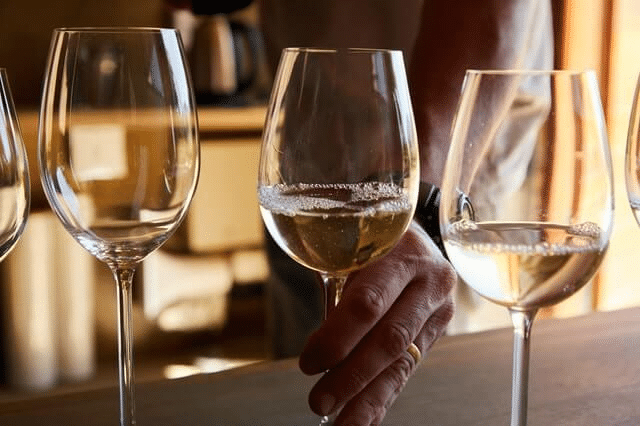Pinot Grigio and Sauvignon Blanc are two renowned white wines. Some wine lovers are fans of both. At the same time, others are devoted to one over the other as personal taste plays a significant role in wine preference.
When it comes to Pinot Grigio vs Sauvignon Blanc, you must educate yourself on the core similarities and differences of these two white grape varietals. Below, we’ll explore each grape’s characteristics and how to distinguish one from the other.
Pinot Grigio vs Sauvignon Blanc: A Brief Summary
Sauvignon Blanc and Pinot Grigio wine both originate from France. However, Pinot Grigio is primarily associated with Italy (the French call this grape Pinot Gris). These white grape varieties produce versatile, distinctive, and aromatic wines.
Many would be unable to distinguish these two wines from each other on looks alone. Despite having similar hues, their flavour profiles set them apart. Pinot Grigio is known for its subtle fruit flavours, while Sauvignon Blanc’s acidity and grassy notes pack a punch upon tasting. Yet, how do these grapes contrast and compare? Let’s explore.
What is Pinot Grigio?
Pinot Grigio is light-bodied, dry white wine, and its best examples have zesty acidity with lemon, lime, green apple and honeysuckle aromas. It is a white mutation of the Pinot family, and the skins have a slight grey-blue to brownish pink hue. This grape grows best in cooler climates however it is known and increasingly planted in less classic wine regions that are warmer in nature. Typically, the fermentation process for Pinot Grigio wine takes place in stainless steel tanks to retain its crisp acidity and fruit forward aromas.
Growing Regions
Pinot Grigio is primarily produced in northern Italy, especially in Alto Adige, Lombardy, and Veneto. Here winemakers make a light-bodied dry wine celebrated as an ‘everyday wine.’ But, Pinot Grigio is grown in many other regions worldwide. Here are some of the most popular:
- Alsace: Known as Pinot Gris in Alsace, this grape has been cultivated across Alsace since the 16th century. Pinot Gris wine from Alsace comes in three styles: dry, off dry, and sweet.
- New Zealand: The Pinot Gris grape is grown all across New Zealand. Unlike an Italian Pinot Grigio, winemakers here produce a full-flavoured wine that is richer in texture.
- California: San Joaquin, Sacramento, and Monterey make the majority of California’s Pinot Grigio wine. These medium-bodied wines have crisp, bright acidity.
Aroma & Flavour Profile
A Pinot Grigio’s flavour profile varies depending on region and producer. However, there are shared similarities between all styles. Aromas can range from notes of bright citrus and peach to honey to more floral scents such as honeysuckle. On the palate, Pinot Grigio is known for hints of citrus fruits, including:
- Lemon
- Lime
- Pear
- Green apple
- Peach
- Apricot
- White flowers
- Almond
- Spices
Style
Pinot Grigio wine is a dry wine, particularly coming from an Italian region. Yet, it is possible to find sweet styles in the Alsace region of France. Winemakers in Alsace harvest the grapes later in the harvest season, resulting in the grapes developing more sugar. Sweet Pinot Grigio is typically more aromatic, has a richer mouth feel and has aromas of candied lemon, honey and almond.
What is Sauvignon Blanc?
Sauvignon Blanc is another white grape varietal that has its roots in France. Found in the Loire Valley and Bordeaux, this white wine is famous for its high acidity and herbaceous flavour profile. Produced worldwide, Sauvignon Blanc is a robust grape capable of adapting to various climates.
Growing Regions
Loire Valley and Bordeaux continue to be main producers of Sauvignon Blanc in Europe. A Loire Valley Sauvignon Blanc produces a zingy wine and has great minerality. This grape is used in various blends in Bordeaux usually accompanied by Semillon, notably to make Bordeaux Blanc.
Other popular growing regions for Sauvignon Blanc are:
- New Zealand: Popularity for New Zealand Sauvignon Blanc has grown exponentially over the years. Winemakers here produce a wine that is fruit-forward, vibrant, grassy and aromatic.
- Chile: Sauvignon Blanc from Chile, particularly Casablanca Valley, is light bodied with citrus and herb notes on the palate.
- California: Napa Valley is one of the biggest producers of Sauvignon Blanc in North America. These wine tends to be richer with more tropical notes than that of other regions—many winemakers in California experiment with clones of Sauvignon Blanc to find the best fit for the hotter climate.
Aroma & Flavour Profile
Sauvignon Blanc has an aromatic flavour profile. You will discover citrus and herbaceous notes on the nose, mainly lemon, green grass and asparagus. In terms of flavours, this can vary depending on where the grapes are grown, but typically you will find hints of grapefruit, passion fruit, and lime as well. For sweet Sauvignon Blancs (the most famous is Sauterne from Bordeaux blended with Semillon), expect notes of honey, ginger, lemon curd, white peach, cinnamon, and beeswax.
Styles
Sauvignon Blanc can be found in various styles depending on the region and winemaking process. These are the three main styles:
- Dry: Sauvignon Blancs that are dry are a result of grapes being picked at an optimal time where acid and sugar are devoted nicely and in balance and the winemaker ferments all the sugar out of the juice. this leaves the wine crisp and fruit forward.
- Sparkling: Mainly in New Zealand, some winemakers produce a sparkling version of Sauvignon Blanc that is tropical and zingy on the palate.
- Sweet: Typically, sweet Sauvignon Blanc is a result of noble rot or botrytis affected grapes which is a fungus that attaches the grapes while still on the vine making them shrivel and therefore water in the grapes is reduced and sugars are concentrated. This variation often displays notes of candied citrus, honeyed apricot, butterscotch, caramel, coconut, mango, ginger and marmalade.
Pinot Grigio vs Sauvignon Blanc: Similarities and Differences
Besides the fact both grapes produce light-bodied crisp wines, the main similarities are their growing regions and alcohol content. Both wines have a moderate alcohol content between 12.5 and 13.5 percent. And both grape varietals are grown in France, New Zealand, and California. What truly sets them apart is their aromatic profile making these grapes have their own personality.
For food and wine pairing, Pinot Grigio is better suited to light Italian pasta or buttery shellfish. On the other hand, Sauvignon Blanc has the acidity to cut through creamy goat’s cheese and oily fish such as sardines or mackerel.
Best Pinot Grigio and Sauvignon Blanc to Explore
For a traditional Pinot Grigio, we recommend the Luigi Righetti Pinot Grigio 2020. This wine promises floral and nutty aromas and plenty of fruit concentration with a clean citrus finish. An ideal wine for enjoying on a hot summer’s day with grilled prawns, this Pinot Grigio will transport you straight to the Veneto vineyard, where it was grown.
Are you looking to sample a famous New Zealand Sauvignon Blanc? Try the Te Mania Sauvignon Blanc 2021 from the Nelson region. A beautiful wine that showcases the intense varietal flavours, this white wine is known for—displaying notes of green apple, fresh herbs, and delicious citrus.
Get in touch with the Small Winemakers today for more white wine recommendations. We’ll be happy to guide you in the right direction. Here’s to your next great glass.



